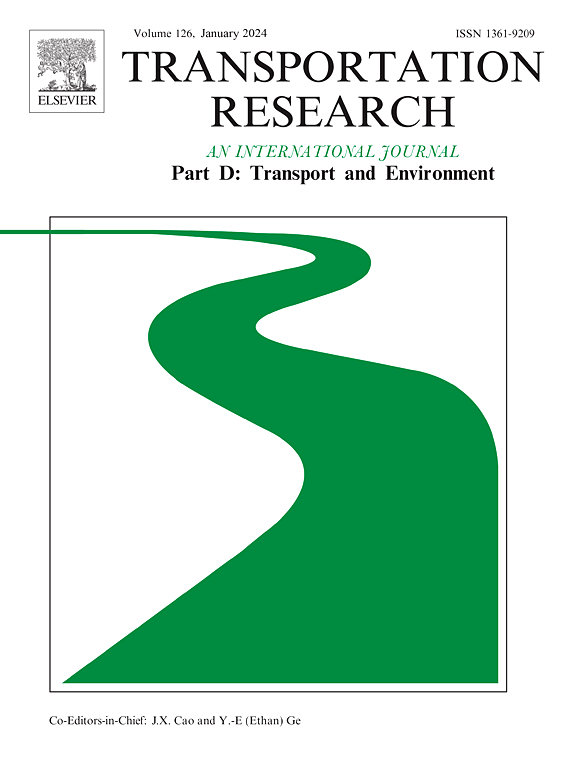Exploring the influence of flooding conditions on crowd evacuation: An experimental study
IF 7.3
1区 工程技术
Q1 ENVIRONMENTAL STUDIES
Transportation Research Part D-transport and Environment
Pub Date : 2025-06-11
DOI:10.1016/j.trd.2025.104868
引用次数: 0
Abstract
Understanding the impact of dynamic water flow on crowd evacuation is essential for improving pedestrian safety under urban floods. Previous research has primarily focused on studying pedestrian movement characteristics in static water scenarios, whereas investigations of pedestrian evacuation under dynamic water flow are still rare. In this study, a series of bottleneck evacuation experiments were performed using a novel experimental flooding setup. Five inflow depths, i.e., 0, 0.3, 0.4, 0.5, and 0.6 m, corresponding to five water flow rates, i.e., 0, 0.225, 0.3, 0.375, and 0.45 m3/s, were designed to simulate dynamic water flow in bottleneck layouts. Two evacuation strategies, including individual evacuation and cooperative evacuation, were considered. How inflow depths and evacuation strategies affect density, speed, and nearest-neighbor distribution at the bottleneck is explored. Our findings demonstrate that the pedestrian speed and flow rate in cooperative scenarios are higher than those in individual scenarios. Total evacuation times are 21.7 %, 10.77 %, 5 %, and 14.85 % faster in cooperative scenarios than those in individual scenarios at inflow depths of 0.3, 0.4, 0.5, and 0.6 m. These results will offer valuable insights for calibrating flood evacuation models and improving crowd management during emergencies.
洪水条件对人群疏散影响的实验研究
了解动态水流对人群疏散的影响,对于提高城市洪涝条件下的行人安全至关重要。以往的研究主要集中在静态水场景下行人运动特征的研究,而对动态水流场景下行人疏散的研究尚不多见。在本研究中,采用一种新型的实验驱油装置进行了一系列的瓶颈抽油实验。设计了0、0.3、0.4、0.5、0.6 m 5个入水深度,分别对应0、0.225、0.3、0.375、0.45 m3/s 5种流量,模拟瓶颈布局的动态水流。考虑了个体疏散和协同疏散两种疏散策略。探讨了流入深度和疏散策略如何影响瓶颈处的密度、速度和最近邻分布。研究结果表明,合作场景下的行人速度和流量高于单独场景下的行人速度和流量。在流入深度为0.3、0.4、0.5和0.6 m时,合作方案的总疏散时间分别比单独方案快21.7%、10.77%、5%和14.85%。这些结果将为校准洪水疏散模型和改善紧急情况下的人群管理提供有价值的见解。
本文章由计算机程序翻译,如有差异,请以英文原文为准。
求助全文
约1分钟内获得全文
求助全文
来源期刊
CiteScore
14.40
自引率
9.20%
发文量
314
审稿时长
39 days
期刊介绍:
Transportation Research Part D: Transport and Environment focuses on original research exploring the environmental impacts of transportation, policy responses to these impacts, and their implications for transportation system design, planning, and management. The journal comprehensively covers the interaction between transportation and the environment, ranging from local effects on specific geographical areas to global implications such as natural resource depletion and atmospheric pollution.
We welcome research papers across all transportation modes, including maritime, air, and land transportation, assessing their environmental impacts broadly. Papers addressing both mobile aspects and transportation infrastructure are considered. The journal prioritizes empirical findings and policy responses of regulatory, planning, technical, or fiscal nature. Articles are policy-driven, accessible, and applicable to readers from diverse disciplines, emphasizing relevance and practicality. We encourage interdisciplinary submissions and welcome contributions from economically developing and advanced countries alike, reflecting our international orientation.

 求助内容:
求助内容: 应助结果提醒方式:
应助结果提醒方式:


